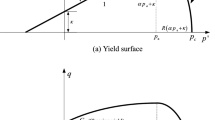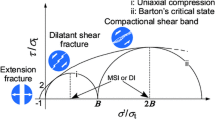Abstract
The deep geological disposal is an internationally recognized method for the disposal of high level radioactive waste. As an essential facility, the construction safety of underground research laboratory (URL) is very important. Taking the China’s first URL in Beishan, Gansu Province as engineering background, considering the influence of arranged joints in rock mass, an elastic–plastic damage numerical method for fractured rock mass is presented and the corresponding subprogram in Flac3D is developed. Based on the numerical calculation of underground research laboratory construction, the optimized excavation scheme of URL is obtained and the distribution rules of surrounding rock displacement field, stress field and plastic damage zone are studied. The research result can provide important guidance for the construction of Beishan URL.




















Similar content being viewed by others
References
Amann F, Button EA, Evans KF, Gischig VS, Blumel M (2011) Experimental study of the brittle behavior of clay shale in rapid unconfined compression. Rock Mech Rock Eng 44(4):415–430
Amann F, Kaiser P, Button EA (2012) Experimental study of brittle behavior of clay shale in rapid triaxial compression. Rock Mech Rock Eng 45(1):21–33
Armand G, Leveau F, Nussbaum C, de La Vaissiere R, Noiret A, Jaeggi D, Landrein P, Righini C (2014) Geometry and properties of the excavation-induced fractures at the Meuse/Haute-Marne URL drifts. Rock Mech Rock Eng 47(1):21–41
Chen SW, Yang CH et al (2017) Evolution of cracks and permeability of granites suffering from different thermal damages. Chin J Geotech Eng 39(08):1493–1500
Deng CF (2017) Mechanical behaviors and acoustic emission characteristics of fracture of granite under different moisture conditions. Chin J Geotech Eng 39(08):1538–1544
Guo YH, Wang J (2007) Key scientific issues of geology, hydrogeology and geochemistry in high-level radioactive waste geological disposal. Chin J Rock Mech Eng 26(S2):3926–3931
Hu SH (2016) Laboratory tests on deformation characteristics of thermally treatedBeishan granite under high pore water pressure. Chin J Geotech Eng 38(S2):330–335
Jobmann M, Wilsnack T, Voigt HD (2010) Investigation of damage-induced permeability of Opalinus clay. Int J Rock Mech Min Sci 47(2):279–285
Kitamura A, Doi R, Yoshida Y (2011) Evaluated and estimated solubility of some elements for performance assessment of geological disposal of high-level radioactive waste using updated version of thermodynamic database. In: Proceedings of the 13th international conference on environmental remediation and radioactive waste management vol 2, pp. 365–373 (2010)
Kwon S, Lee CS, Cho SJ, Jeon SW, Cho WJ (2009) An investigation of the excavation damaged zone at the KAERI underground research tunnel. Tunnel Underg Space Technol 24(1):1–13
Lan H (2007) Constitutive model of joint rock mass damage due to mining and its application in engineering of open underground combined mining. Dissertation, China coal research institute
Lei GW, Yang CH et al (2016) Geometric features of joints and quality evaluation of rock mass in Xinchang section, Beishan. Chin J Rock Mech Eng 35(05):896–905
Li SC (2010) The failure mechanism and engineering application of anchor fracture joints. Science Press, Beijing
Li SC, Li SC (2000) Fracture-damage stability analysis of underground powerhouse in right bank of Three Gorges. Rock Soil Mech 21(3):193–197
Li SC, Wang SF (2001) 3D fracture-damage analysis on the stability of the rockmass surrounding underground powerhouse in right bank of the three gorges project. Chin J Rock Mech Eng 20(05):685–689
Liu YM, Wang J (2007) Basic physico-mechanical properties and time-temperature effect of deep intact rock from Beishan preselected area for high-level radioactive waste disposal. Chin J Rock Mech Eng 26(10):2034–2042
Luo SH, Qian QH et al (2004) Deep geological disposal of high-level nuclear waste and its research outlines. Chin J Rock Mech Eng 23(05):831–838
Nakayama S, Watanabe Y, Kato M (2011). Regulatory research for geological disposal of high-level radioactive waste in Japan. In: Proceedings of the 13th international conference on environmental remediation and radioactive waste management vol 2, pp. 279–285 (2010)
Wang P, Li XZ (2014) GIS based research on spatial patterns of fractures in granitic rock. J Eng Geol 21(06):1086–1093
Wang J, Liu YM (2003) High-level radwaste repository and rock mechanics. Rock Soil Mech 24(S2):636–638
Wang J, Chen WM et al (2006) Geological disposal of high-level radioactive waste and its key scientific issues. Chin J Rock Mech Eng 25(04):801–812
Yi SM, Zhu ZD (2005) Fracture rock mass damage mechanics introduction. Science Press, Beijing
Zhang QY, Xiang W (2000) Application of 3D elastoplastic damage model with bolts in Xiluodu underground power house. Chin J Comput Mech 17(04):475–482
Zhang QY et al (2005a) 3D damage rock-bolt reinforcing model with application in Dananshan land slide prevention of shenzhen. China Civil Eng J 38(04):116–119
Zhang QY et al (2005b) Computatioinof fracture failure strength for jointed rockmass and its application in engineering. J Shandong Univ (Eng Sci) 35(01):98–101
Zhang QY, Li SC et al (2005c) The numerical analysis method of rock mass and the test principle and engineering application of geological mechanics model. China water Conservancy and Hydropower Press, Beijing
Zhao XG, Li PF (2014) Damage and dilation characteristics of deep granite at Beishan under cyclic loading-unloading conditions. Chin J Rock Mech Eng 33(09):1740–1748
Acknowledgements
This study was financially supported by the Key Research Development Project of China (No. 2016YFC0401804) and the Taishan Scholars Project Foundation d of Shandong Province and the Natural Science Foundation Project of China (No. 41772282) and the Preliminary research project of the underground laboratory for the geological disposal of high level radioactive waste (No. YK-KY-J-2015-25).
Author information
Authors and Affiliations
Corresponding author
Rights and permissions
About this article
Cite this article
Ren, My., Zhang, Qy., Liu, Cc. et al. The Elastic–Plastic Damage Analysis of Underground Research Laboratory Excavation for Disposal of High Level Radioactive Waste. Geotech Geol Eng 37, 1793–1811 (2019). https://doi.org/10.1007/s10706-018-0723-4
Received:
Accepted:
Published:
Issue Date:
DOI: https://doi.org/10.1007/s10706-018-0723-4




